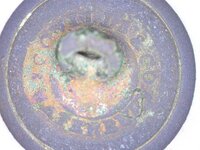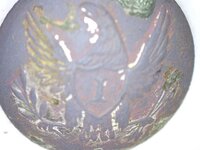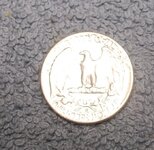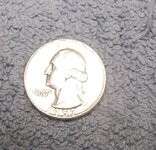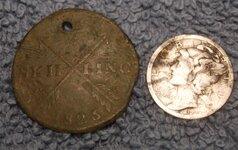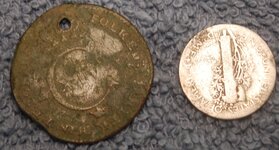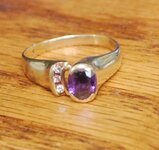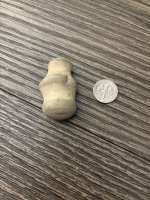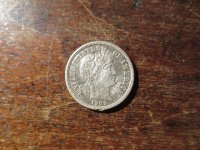You are using an out of date browser. It may not display this or other websites correctly.
You should upgrade or use an alternative browser.
You should upgrade or use an alternative browser.
Sluice boxes.
- Thread starter blazen70
- Start date
Highmountain
Hero Member
It helps keep out the riff-raff, Blazen. Assuming you're talking about a grizzly.
If you're talking about something sitting on top of the carpet or other material in the bottom to hold it down and keep it from washing downstream. In the bottom the carpet or other material, maybe including expanded metal if it's there, changes the speed, direction and energy of the water flowing over it. When that energy is reduced enough so the water can no longer carry the heavy material, it drops it to the bottom, where it will hopefully be trapped in the carpet or by the riffles.
If it's across the top, I suppose the expanded metal acts as a grizzly to allow you to work with material that's smaller and more consistent than it would be if you didn't have a grizzly. Most sluices don't have it, but it means you end up picking out the larger rocks all the time.... to be honest, I don't believe I've ever seen a sluicebox with a grizzly.
But then, most sluices work you pretty hard and force you to submerge your hands in ice-cold water a lot more than you might wish. A grizzly on a sluice mightn't be a bad idea.
I think all high-bankers and drywashers have them, probably wouldn't work well at all, without them.
Best to you,
Jack
If you're talking about something sitting on top of the carpet or other material in the bottom to hold it down and keep it from washing downstream. In the bottom the carpet or other material, maybe including expanded metal if it's there, changes the speed, direction and energy of the water flowing over it. When that energy is reduced enough so the water can no longer carry the heavy material, it drops it to the bottom, where it will hopefully be trapped in the carpet or by the riffles.
If it's across the top, I suppose the expanded metal acts as a grizzly to allow you to work with material that's smaller and more consistent than it would be if you didn't have a grizzly. Most sluices don't have it, but it means you end up picking out the larger rocks all the time.... to be honest, I don't believe I've ever seen a sluicebox with a grizzly.
But then, most sluices work you pretty hard and force you to submerge your hands in ice-cold water a lot more than you might wish. A grizzly on a sluice mightn't be a bad idea.
I think all high-bankers and drywashers have them, probably wouldn't work well at all, without them.
Best to you,
Jack
Attachments
blazen70
Full Member
- Thread starter
- #3
If you're talking about something sitting on top of the carpet or other material in the bottom to hold it down and keep it from washing downstream. In the bottom the carpet or other material, maybe including expanded metal if it's there, changes the speed, direction and energy of the water flowing over it. When that energy is reduced enough so the water can no longer carry the heavy material, it drops it to the bottom, where it will hopefully be trapped in the carpet or by the riffles.
That's exactly what I was talking about. Most commercially made sluices don't have this but, alot of "homemade" ones do. I was just wondering if the option of having expanded metal in a sluice made any improvement in recovery or is it just excess weight. In other words if the riffles and carpet alone work good then why add expanded metal? Unless it was an improvement?
Robert
Attachments
Highmountain
Hero Member
After I made this post a guy who saw it told me he liked to put a piece of expanded metal braced on rocks at the upstream end of the sluice with an old bathtowel under the rocks below, but on the top of whatever covers the bottom. Said the expanded metal saves him a lot of work with large material (he just pickes it up and dumps it pretty frequently... and the towel below is a lot easier to clean than the carpet... he still burns and pans the carpet, but not so often... burns the towels instead.
Jack
Jack
Chris in BC
Full Member
- Mar 19, 2003
- 155
- 38
- Detector(s) used
-
Minelab X-Terra 705
Keene 5" dredge
- Primary Interest:
- All Treasure Hunting
the expanded is critical to opperating a sluice properly, moss or carpet wont do everything, the expanded acts as smaller riffles and creates small back preassures throughout the sluicebox,,, I dont care if it's nuggets or fines, it is critical.
Punchplate in a sluicebox works great for a classifier, but requires some work to shear it down and tack together. Most guys pre-classify everything before running it through the sluice.
Punchplate in a sluicebox works great for a classifier, but requires some work to shear it down and tack together. Most guys pre-classify everything before running it through the sluice.
Attachments
-
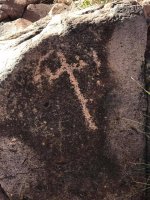 5.jpg139.5 KB · Views: 15
5.jpg139.5 KB · Views: 15 -
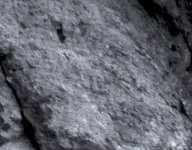 4.jpg66.6 KB · Views: 17
4.jpg66.6 KB · Views: 17 -
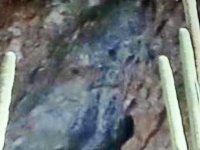 3.jpg58.7 KB · Views: 16
3.jpg58.7 KB · Views: 16 -
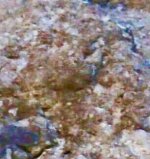 2.jpg19.5 KB · Views: 11
2.jpg19.5 KB · Views: 11 -
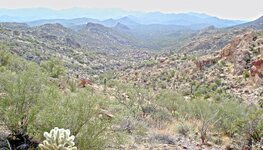 backside hewitt.JPG856.2 KB · Views: 12
backside hewitt.JPG856.2 KB · Views: 12 -
 cross_heart.JPG15.7 KB · Views: 16
cross_heart.JPG15.7 KB · Views: 16 -
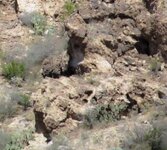 image.jpeg70.4 KB · Views: 15
image.jpeg70.4 KB · Views: 15 -
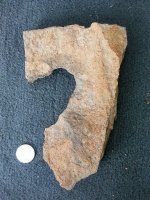 12540527_184188135271279_2877287568224105495_n.jpg158.2 KB · Views: 11
12540527_184188135271279_2877287568224105495_n.jpg158.2 KB · Views: 11 -
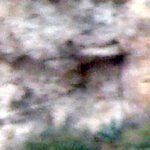 sealed.JPG21.2 KB · Views: 14
sealed.JPG21.2 KB · Views: 14 -
 12622149_184259235264169_3436846075369413951_o.jpg138.2 KB · Views: 10
12622149_184259235264169_3436846075369413951_o.jpg138.2 KB · Views: 10 -
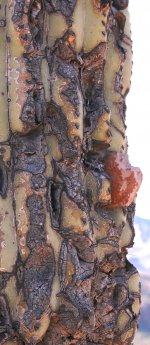 12640482_184259161930843_1810684286815826715_o.jpg248.7 KB · Views: 12
12640482_184259161930843_1810684286815826715_o.jpg248.7 KB · Views: 12 -
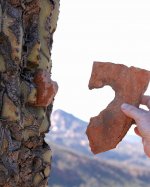 7.jpg85.5 KB · Views: 11
7.jpg85.5 KB · Views: 11 -
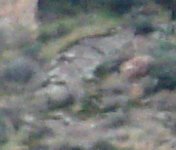 6.jpg11.2 KB · Views: 10
6.jpg11.2 KB · Views: 10 -
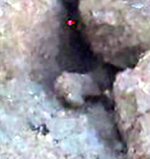 Untitled..jpg67.6 KB · Views: 14
Untitled..jpg67.6 KB · Views: 14 -
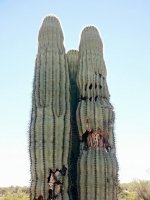 10384234_1385979418376742_3074731452586145111_n.jpg76 KB · Views: 14
10384234_1385979418376742_3074731452586145111_n.jpg76 KB · Views: 14 -
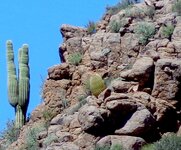 DSC01718.jpg526.9 KB · Views: 14
DSC01718.jpg526.9 KB · Views: 14 -
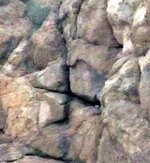 heart and cross.jpg29.7 KB · Views: 14
heart and cross.jpg29.7 KB · Views: 14 -
 12605367_184259251930834_8521867066696577157_o.jpg84.4 KB · Views: 11
12605367_184259251930834_8521867066696577157_o.jpg84.4 KB · Views: 11
Highmountain
Hero Member
Operating a sluice 'properly'
All a matter of degree. The phrase, 'operate a sluice properly' carries the implication that no gold was ever worked, no sluiceboxes ever capable of recovering gold until carpet and expanded metal came along.
The pic is a long-tom, 1860s vintage, hacked from a log, a channel hollowed the length of the top (by axe).. it's on my webpage http://www.jackpurcellbooks.us/pages/book pages/1998 search.htm as part of what we found on the 1998 search... this one was buried, but once uncovered it was clear they didn't use any carpet and expanded metal, but still tried to get by. Evidently they used rocks for riffles on a flat bottom which was as smooth a s a good man with an axe could get it... there was a notch on the discharge end to allow some easy flow out and (evidently) a rag hung on the discharge to provide a bit of filter for the outflow... a hand forged nail was driven into the log wall just upstream of the notch.
On the other hand, I doubt they were able to properly use this production device because of the limitations of not yet having invented expanded metal and the difficulties of carrying carpet by horseback over terrain infested by Apaches 150 miles. (Evidence on the site suggested these guys didn't make the home trip).
Their burned out cabin ruin was 150 feet downstream and to the right.. you can't see it in the picture, nor the arrastra, downstream to the right, also, but only about 30 feet from the discharge of the longtom just below that deadfall on the right.
Evidently they were working some lode as well as placer and floating off the quartz in the longtom after crushing it with the arrastra.
Technology's great, but gold's heavy and it will find any means it can to find the place closest to the center of the Earth. Nature's been concentrating the stuff in placers fairly efficiently every since it discovered how heavy the stuff is.
The fact is almost anything from grooves cut into bedrock bottom to a corrugated pipe works a lot better than it has any business doing. I've sometimes wondered what the Aztecs used. I saw a book or pics somewhere of the gold pans currently in use by miners in South America once. The pans resembled funnels more than anything else that comes to mind. But evidently they do the job.
Best to you,
Jack
All a matter of degree. The phrase, 'operate a sluice properly' carries the implication that no gold was ever worked, no sluiceboxes ever capable of recovering gold until carpet and expanded metal came along.
The pic is a long-tom, 1860s vintage, hacked from a log, a channel hollowed the length of the top (by axe).. it's on my webpage http://www.jackpurcellbooks.us/pages/book pages/1998 search.htm as part of what we found on the 1998 search... this one was buried, but once uncovered it was clear they didn't use any carpet and expanded metal, but still tried to get by. Evidently they used rocks for riffles on a flat bottom which was as smooth a s a good man with an axe could get it... there was a notch on the discharge end to allow some easy flow out and (evidently) a rag hung on the discharge to provide a bit of filter for the outflow... a hand forged nail was driven into the log wall just upstream of the notch.
On the other hand, I doubt they were able to properly use this production device because of the limitations of not yet having invented expanded metal and the difficulties of carrying carpet by horseback over terrain infested by Apaches 150 miles. (Evidence on the site suggested these guys didn't make the home trip).
Their burned out cabin ruin was 150 feet downstream and to the right.. you can't see it in the picture, nor the arrastra, downstream to the right, also, but only about 30 feet from the discharge of the longtom just below that deadfall on the right.
Evidently they were working some lode as well as placer and floating off the quartz in the longtom after crushing it with the arrastra.
Technology's great, but gold's heavy and it will find any means it can to find the place closest to the center of the Earth. Nature's been concentrating the stuff in placers fairly efficiently every since it discovered how heavy the stuff is.
The fact is almost anything from grooves cut into bedrock bottom to a corrugated pipe works a lot better than it has any business doing. I've sometimes wondered what the Aztecs used. I saw a book or pics somewhere of the gold pans currently in use by miners in South America once. The pans resembled funnels more than anything else that comes to mind. But evidently they do the job.
Best to you,
Jack
Users who are viewing this thread
Total: 2 (members: 0, guests: 2)


